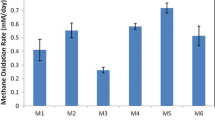Abstract
The magnitude of methane emission is a net result of methane production and the oxidation rate. The possibility of measuring oxidized products of alternative substrates of methane monooxygenase was examined to determine methane-oxidizing ability of soils, and to count methanotrophic populations in soils. Wetland rice soils were incubated under methane containing air to enirch the methanotrophs. Methane loss and oxygen uptake were inhibited by acetylene, dimethylether, and nitrapyrin (N-Serve). Acetylene was used routinely, because it inhibited methane oxidation even at a low concentration of 0.03 to 0.06 μl ml-1 in the incubation headspace. Propylene at 10 kPa was used as an alternative substrate of methane monooxygenase, and the formation of propylene oxide was measured. When soils were incubated under methane, their methane-oxidizing activity increased. Propylene oxide formation increased simultaneously. Acetylene also blocked propylene oxidation. The results of several experiments and propylene oxide formation (r=0.87 after long-transformation). These results indicate that propylene oxide formation can be used as a semiquantitative measure of the methane-oxidizing activity of soils. The colonies of soluble methane monooxygenase-forming methanotrophs were counted on Cu-deficient methanotroph agar medium by the formation of naphthol from haphthalene. The counts increased from 104 (0 days) to 107 (21 days) g-1 soil during oxic incubation under methane.
Similar content being viewed by others
References
Bachelet D, Neue HU (1993) Methane emissions from wetland rice areas of Asia. Chemosphere 26:219–237
Bont JAM de, Lee KK, Bouldin DF (1978)Bacterial oxidation of methane in a rice paddy. Ecol Bull (Stockholm) 26:91–96
Brusseau GA, Tsien HC, Hanson RS, Wackett LP (1990) Optimization of trichloroethylene oxidation by methanotrophs and use of a colorimetric assay to detect soluble methane monooxygenase activity. Biodegradation 1:19–29
Conrad R, Rothfuss F (1991) Methance oxidation in the soil surface layer of a flooded rice field and the effect of ammonium. Biol Fertil Soils 12:28–32
Fox BG, Lipscom JD (1988) Purification of a high specific activity methane monooxygenase hydroxylase component from a type II methanotroph. Biochem Biophys Res Commun 154:165–170
Graham DW, Korich DG, LeBlanc RP, Sinclair NA, Arnold RG (1992) Application of a colorimetric plate assay for soluble methane monooxygenase activity. Appl Environ Microbiol 58:2231–2236
Henrysson T, McCarty PL (1993) Influence of the endogenous storage lipid poly-beta-hydroxybutyrate on the reducing power availability during cometabolism of trichloroethylene and naphthalene by resting methanotrophic mixed cultures. Appl Environ Microbiol 59:1602–1606
Hou CT, Patel R, Laskin A, Barnabe N (1979) Microbial oxidation of gaseous hydrocarbons: epoxidation of C2 to C4 n-alkenes by methylotrophic bacteria. Appl Environ Microbial 38:127–134
Inubushi K, Muramatsu Y, Umebayashi M (1992) Quantitative balance of methane production oxidation and emission in paddy soil ecosystem. UNESCO MAB Report, Tokyo, pp 91–94
Knowles R (1993) Methance: Processes of production and consumption. In: Agricultural ecosystem effects on trace gases and global climate change. AM Soc Agron, Madison, Wis, pp 145–156
Lindstrom ME, Stirling DI (1990) Methylotrophs: genetics and commercial applications. Annu Rev Microbiol 44:27–58
Oremland RS, Culbertson CW (1992) Importance of methane-oxidizing bacteria in the methance budget as revealed by the use of a specific inhibitor. Nature 356:421–423
Rotmans J, Elzen MGJ den, Krol MS, Swart RJ, Woerd HJ van der (1992) Stabilizing atmospheric concentrations: towards international methane control. Ambio 21:404–413
Takeda K (1988) Characteristics of a nitrogen-fixing methanotroph, Methylocystis T-1. Antonie von Leeuwenhoek J Microbiol Serol 54:521–534
Vries GE de, Kues U, Stahl U (1990) Physiology and genetics of methylotrophic bacteria. FEMS Microbiol Rev 75:57–102
Author information
Authors and Affiliations
Rights and permissions
About this article
Cite this article
Watanabe, I., Takada, G., Hashimoto, T. et al. Evaluation of alternative substrates for determining methane-oxidizing activities and methanotrophic populations in soils. Biol Fertil Soils 20, 101–106 (1995). https://doi.org/10.1007/BF00336587
Received:
Issue Date:
DOI: https://doi.org/10.1007/BF00336587




